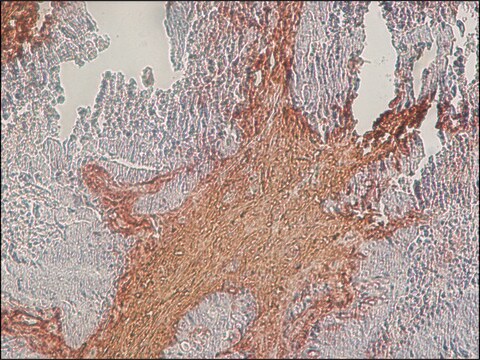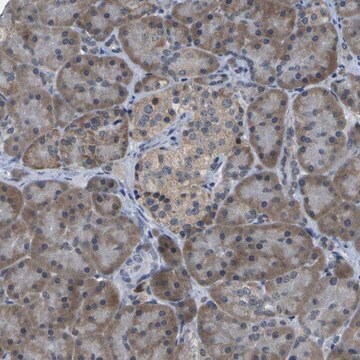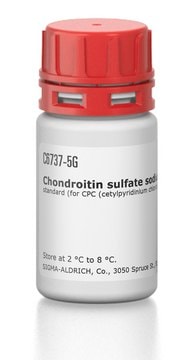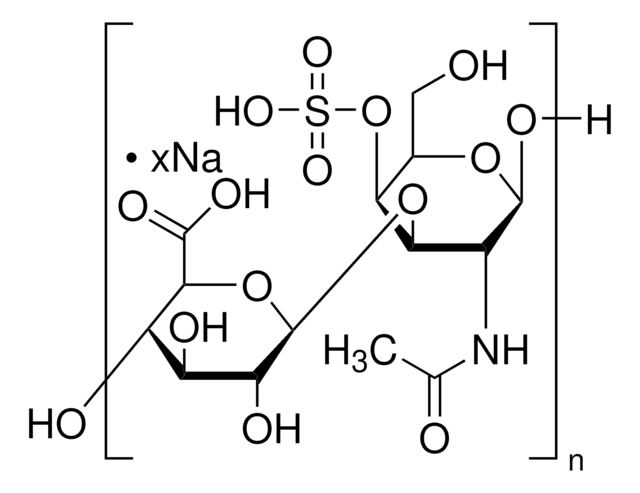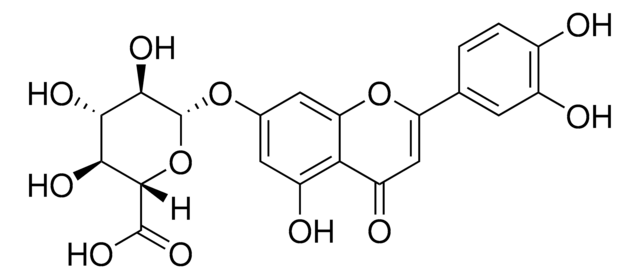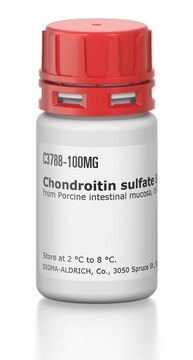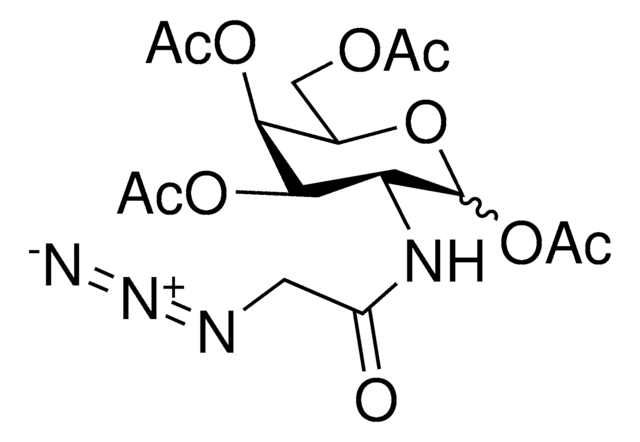おすすめの製品
由来生物
mouse
品質水準
抗体製品の状態
purified antibody
抗体製品タイプ
primary antibodies
クローン
373E1, monoclonal
分子量
observed mol wt ~N/A kDa
精製方法
affinity chromatography
化学種の反応性
chicken, human
化学種の反応性(ホモロジーによる予測)
vertebrates
包装
antibody small pack of 100
テクニック
ELISA: suitable
immunohistochemistry: suitable
immunoprecipitation (IP): suitable
western blot: suitable
アイソタイプ
IgMκ
タンパク質IDアクセッション番号
UniProtアクセッション番号
保管温度
-10 to -25°C
特異性
Clone 373E1 is a mouse monoclonal antibody that detects Keratan sulfate in cartilage tissue.
免疫原
Purified proteoglycans from embryonic chicken.
アプリケーション
Quality Control Testing
Evaluated by Immunohistochemistry (Paraffin) in Human cartilage tissue sections.
Immunohistochemistry (Paraffin) Analysis: A 1:50 dilution of this antibody detected Keratan Sulfate in human cartilage tissue sections.
Tested Applications
Western Blotting Analysis: A representative lot detected Keratan Sulfate in Western Blotting application (Magro, G., et al. (2003). Am J Pathol. 163(1):183-96).
Immunoprecipitation Analysis: A representative lot immunoprecipitated Keratan Sulfate in Immunoprecipitation application (Magro, G., et al. (2003). Am J Pathol. 163(1):183-96).
Immunohistochemistry Applications: A representative lot detected Keratan Sulfate in Immunohistochemistry application (Magro, G., et al. (2003). Am J Pathol. 163(1):183-96).
ELISA Analysis: A representative lot detected Keratan Sulfate in ELISA application (Magro, G., et al. (2003). Am J Pathol. 163(1):183-96).
Note: Actual optimal working dilutions must be determined by end user as specimens, and experimental conditions may vary with the end user.
Evaluated by Immunohistochemistry (Paraffin) in Human cartilage tissue sections.
Immunohistochemistry (Paraffin) Analysis: A 1:50 dilution of this antibody detected Keratan Sulfate in human cartilage tissue sections.
Tested Applications
Western Blotting Analysis: A representative lot detected Keratan Sulfate in Western Blotting application (Magro, G., et al. (2003). Am J Pathol. 163(1):183-96).
Immunoprecipitation Analysis: A representative lot immunoprecipitated Keratan Sulfate in Immunoprecipitation application (Magro, G., et al. (2003). Am J Pathol. 163(1):183-96).
Immunohistochemistry Applications: A representative lot detected Keratan Sulfate in Immunohistochemistry application (Magro, G., et al. (2003). Am J Pathol. 163(1):183-96).
ELISA Analysis: A representative lot detected Keratan Sulfate in ELISA application (Magro, G., et al. (2003). Am J Pathol. 163(1):183-96).
Note: Actual optimal working dilutions must be determined by end user as specimens, and experimental conditions may vary with the end user.
ターゲットの説明
Keratan sulfate (also known as keratosulfate) is a widely distributed glycosaminoglycan in tensional and weight-bearing connective tissues, epithelial tissues, and the central and peripheral nervous system. It is attached to a number of proteoglycan and glycoprotein core proteins. Three types of keratan sulfate have been described: KS I, KS II, and KS III depending on their distribution pattern. Keratan sulfate is the only glycosaminoglycan (GAG) that does not contain uronic acid; therefore, it is not cleavable by the eliminative enzymatic cleavage. The biosynthesis of keratan sulfate occurs in two stages. In the first stage, the region binding the core protein with GAG is created followed by the elongation of the chain and its modification. The elongation of keratan sulfate chains of all types occurs by alternate attaching of Gal and GlcNAc residues, catalyzed by β-1,4-galactotransferase and β-1,3-N-acetyloglucosaminotransferase, respectively. Sulfation of keratan sulfate is carried out by at least two sulfotransferases. Gal 6-O-sulfotransferase transfers sulfate to position 6 of Gal residues located in the internal region of keratan sulfate and GlcNAc 6-O-sulfotransferase transfers sulfate to position 6 of GalNAc residues located at the nonreducing terminal of keratan sulfate. Clone 373E1 is a monoclonal antibody that detects a unique sialylation/ conformational-dependent KS epitope that detects a novel glycoprotein complex produced by papillary thyroid carcinoma cells. (Ref.: Magro, G., et al. (2003) Am. J. Pathol. 163(1); 183-196; Caterson, B., et al. (1982). J. Invest. Dermatol. 79 (suppl 1); 45-50; Coleman, PJ., et al. (1998). J. Physiol. 509(3); 695-710).
物理的形状
Purified mouse monoclonal antibody IgM in PBS without preservatives.
再構成
1.0 mg/mL. Please refer to guidance on suggested starting dilutions and/or titers per application and sample type.
保管および安定性
Store at -10°C to -25°C. Handling Recommendations: Upon receipt and prior to removing the cap, centrifuge the vial and gently mix the solution. Aliquot into microcentrifuge tubes and store at -20°C. Avoid repeated freeze/thaw cycles, which may damage IgG and affect product performance.
その他情報
Concentration: Please refer to the Certificate of Analysis for the lot-specific concentration.
免責事項
Unless otherwise stated in our catalog or other company documentation accompanying the product(s), our products are intended for research use only and are not to be used for any other purpose, which includes but is not limited to, unauthorized commercial uses, in vitro diagnostic uses, ex vivo or in vivo therapeutic uses or any type of consumption or application to humans or animals.
適切な製品が見つかりませんか。
製品選択ツール.をお試しください
保管分類コード
12 - Non Combustible Liquids
WGK
WGK 2
引火点(°F)
Not applicable
引火点(℃)
Not applicable
適用法令
試験研究用途を考慮した関連法令を主に挙げております。化学物質以外については、一部の情報のみ提供しています。 製品を安全かつ合法的に使用することは、使用者の義務です。最新情報により修正される場合があります。WEBの反映には時間を要することがあるため、適宜SDSをご参照ください。
Jan Code
MABT1324-25UG:
MABT1324-100UG:
試験成績書(COA)
製品のロット番号・バッチ番号を入力して、試験成績書(COA) を検索できます。ロット番号・バッチ番号は、製品ラベルに「Lot」または「Batch」に続いて記載されています。
ライフサイエンス、有機合成、材料科学、クロマトグラフィー、分析など、あらゆる分野の研究に経験のあるメンバーがおります。.
製品に関するお問い合わせはこちら(テクニカルサービス)